Notes: Bishopsbourne was not planned as an intermediate station but was built at the suggestion of the oldest son of Matthew Bell, owner of the Bourne Park Estate. Following the resolution of an acrimonious 20-year relationship between the estate and the South Eastern Railway over the acquisition of land, the SER board were keen to appease the Bell family. They agreed to build a station at Bishopsbourne, on the understanding that the land was given free by the estate. The station was later to justify its construction.
The three stations on the northern section of the line were expected to generate less traffic than those further south, and they were provided with cheaper buildings bought from an outside contractor. The single-storey building at Bishopsbourne was corrugated iron over a timber frame and was similar to some stations on Colonel Stephens' light railways. The SER provided a standard waiting shelter and signal box. A lamp room, also made of corrugated iron over a timber frame, stood at the back of the down platform at the south end of the station building.
The station was at the end of a short approach road, with a rather grand stationmaster's house standing on Crows Camp Road at the top of the approach road. Map evidence suggests that it was built in the 20th century.
Bishopsbourne had a small goods yard on the down side of the line, with a single siding running into a small dock behind the down platform. Access to the yard was controlled by a signal box to the north of the station on the down side. A platelayers' hut and a trolley shed were sited on the north side of the siding. Throughout its life, passengers crossed the line using barrow crossings at both ends of the station.
In an attempt to keep costs down, the Southern Railway moved the Bishopsbourne stationmaster to another station, and his duties were performed by two porter-signalmen, one on early turn and the other on later turn. Their combined duties included stationmaster, ticket collector and clerk. In 1931 the line was singled, and the up platform was taken out of use. The station then came under the control of Percy Hardy, the stationmaster at Elham. From 1932 there was a further staff reduction with only one porter-signalman employed. The station was then unlit at night and passengers on some services had to notify the guard if they wanted the train to stop. The last train always stopped as the guard had to lock the station for the night.
In the year ending September 1940 only 1,355 passenger tickets were issued (compared with 1,408 at Barham and 97 at Bridge) and 372 were collected. 93 parcels were sent and 206 were received. The station did not handle coal, but had a healthy traffic in milk with 7,208 cans being dispatched. Other goods traffic was light with little livestock (ten horses out and one in) with 34 tons of general merchandise being received and 78 tons dispatched.
On 25 October 1940 the passenger and goods services through Bishopsbourne were suspended when the line came under military control. The station officially closed from 1 December 1940, but the Elham Military Railway ran trains for military personnel, and members of the public were allowed to travel on these trains at their own risk. Tickets were issued - see two examples below.
The Boche-Buster rail mounted gun was kept in the Bourne Park tunnel half-a-mile north of the station. The gun battery had its headquarters at Charlton Park but used Bishopsbourne station as offices; mess and sleeping coaches were shunted into the siding. The Prime Minister, Winston Churchill inspected the gun at Bishopsbourne on 20 June 1941.
The goods service was reinstated on 19 February 1945, but it was short-lived as the line closed completely on 1 October 1947.
BRIEF HISTORY OF THE ELHAM VALLEY RAILWAY
In 1832 the Kentish Railway Company proposed a line from Canterbury to Folkestone as part of their 1824 scheme to build a line from London to Dover via Canterbury, from where lines would diverge to serve a number of large towns. The company was unable to generate much enthusiasm from potential local backers, and the project was quickly dropped.
Although this scheme failed, a line was soon built between London and Dover. On 21 June 1836, Parliament passed an Act incorporating the South Eastern & Dover Railway, which shortly afterwards became the South Eastern Railway. The new company was formed to construct a route from London to Dover.
The engineer of the Dover line was William Cubitt who was also engineer of the London & Croydon Railway. The chosen route, which passed over the lines of three other companies, would start at London Bridge, from where it would use London & Greenwich metals as far as Southwark and then turn south towards Croydon. From a junction with the London & Croydon at Norwood the Dover line would then share the London and Brighton main line to Redhill where it would turn east towards Tonbridge, Ashford and Folkestone.
Construction began in 1838 at several places simultaneously. The L&BR line to Redhill opened on 12 July 1841 and the SER line from Redhill to Tonbridge on 26 May 1842, when SER train services began. The line reached Ashford on 1 December 1842; the outskirts of Folkestone by 28 June 1843; and Dover by 7 February 1844.
During 1846 the SER opened another secondary main line from Ashford to Ramsgate through the Stour valley, with a branch from there to Margate opening on 1 December 1846. This line passed through Canterbury, which was now linked to Folkestone by a 25-mile circuitous route.
The 16-mile direct route from Folkestone to Canterbury follows two valleys with the Nailbourne stream running north from Lyminge and the Seabrook running south. Collectively they are known as the Elham valley, named after the settlement of Elham. Located in the upper slopes of the valley are a number of examples of unimproved chalk downland such as Baldock Downs and Park Gate Down. At Bishopsbourne and North Lyminge there are examples of traditional sheep-grazed pasture and water meadows.
In 1776 there was a weekly stagecoach service through the valley. The road was in a very poor state of repair, however, and was frequently flooded and often impassable in the winter. There was clearly a demand, particularly from the poor tenant farmers in the valley, for a reliable means of getting their produce to market and for bringing goods in, especially coal.
By 1856 the SER completed its hold on south-east England when it opened a line between Chatham and Maidstone. This domination was soon to be challenged when the promoters of a new line from Canterbury to Chatham offered to lease it to the SER once completed. The SER turned down the offer as they were confident they would be able to buy it cheaply after construction.
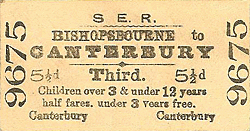 |
Having obtained their Act in 1853, the Mid-Kent (later East Kent) Railway was soon in financial difficulty, but they managed to secure sufficient finance to continue construction towards Canterbury. The line was again offered to the SER, who again turned it down. This was soon to prove a bad decision as in 1855 the East Kent received parliamentary approval to extend their |
line south to Dover. Three years later they obtained running powers across the Medway into London. In 1859 what had started as a purely local venture became the London Chatham & Dover Railway, which would soon become a major competitor of the SER.
This rivalry was soon to be used to the advantage of a number of influential landowners in Lyminge who had previously been unsuccessful in persuading the SER to build a line through the sparsely-populated Elham valley. In an attempt to get a line built, the first Elham Valley Railway prospectus was published in 1865 with wide support, in particular from the church which saw it as an opportunity to increase the size of their congregations. The proposal was for a line running from Hythe to Canterbury where it would make a junction with the LCDR, and junctions at both ends with the SER. The proposed route passed through some difficult terrain with steep gradients at each end of the line and a 600-yard tunnel at Etchinghill.
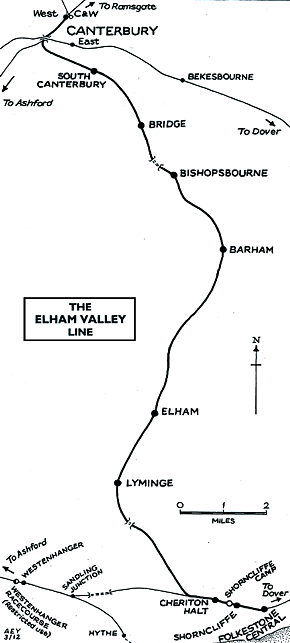 |
It was stated that the proposed line would provide a new direct route into London, with heavy traffic expected between the capital and the south coast. The promoters also claimed that their line would be of strategic national importance during the expected French invasion, providing a direct link between the Shorncliffe Camp at Cheriton which opened in the late 1790s, the military base at Hythe and the Woolwich Arsenal. It would also be of huge benefit to the farmers of the Elham valley and would bring a cheap supply of coal into the region.
A Bill was put before Parliament in the winter of 1866, but this was opposed by both the LCDR and the SER. Although now sanctioned by Parliament, the company was unable to raise sufficient capital, and one by one the company directors lost interest leaving the board in disarray. After the company secretary disappeared, having embezzled a large sum of money and destroyed company records, the remaining directors applied to the Board of Trade for permission to abandon the project; in January 1873 this was granted.
During the next decade both the SER and LCDR expanded their networks, with proposals for many branch lines often encroaching into each other’s territory. Some of these were built, others fell by the wayside.
Relations between the two companies had |
always been strained and became even more so when the LCDR were awarded a lucrative cross-Channel mail contract after the SER had turned it down. In 1879 both companies submitted new proposals for a line through the Elham Valley. The LCDR submitted their scheme first and, not to lose out to its rival, this was closely followed by the SER, who proposed a line from a junction with their own main line at Cheriton to a junction with their Stour Valley line at Canterbury.
The nominally independent Elham Valley Railway Company was established, but the three principal directors had strong links with the SER. The proposal was for a single-track light railway to be built under the 1864 Board of Trade Railway Companies Powers Act. The Bill was presented to Parliament in January 1880 but was withdrawn before the first reading after objections were received, including one from Matthew Bell, the owner of Bourne Park estate. A modified Bill was presented to Parliament the following year with guaranteed finance from the SER.
| The Bill had a shaky passage with continued opposition from landowners in the valley and from the LCDR, but it was eventually passed on 28 July 1881. Having received authority the SER were, however, in no hurry to actually build the line. Despite losing this round, the LCDR were determined to reach Folkestone and quickly revived an earlier proposal to build a double-track line along the Alkham Valley from Kearsney, on its Canterbury to Dover line, to a new terminus at Folkestone, from where it |
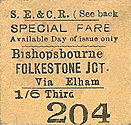 |
hoped to reach London by paralleling the SER. A Bill was prepared to put before Parliament in 1884.
In an attempt to block this new financially damaging route, the SER revived the Elham Valley line with new enthusiasm. A vigorous and often acrimonious local campaign followed with both companies promoting the merits of their route. Although the Elham Valley line had already been sanctioned by Parliament it was only to be a light railway and, as such, could not be fully integrated into the SER network. At the request of the SER, the Elham Valley board met in March 1884 and agreed to upgrade the line to the same standard as the rest of the rail network,and this was authorised as part of the South Eastern's 1884 Various Powers Act. As part of this Act the local company was dissolved, with its powers being vested in the SER. Full transfer would not take place, however, until the new line was completed.
The LCDR eventually withdrew its Alkham Valley Bill leaving the way clear for the South Eastern to start construction of the Elham Valley, a line it had never really wanted but had been forced to build as the only way of stopping the LCDR. The SER's early misgivings about the route were soon proved to be correct.
The South Eastern's chief engineer, Francis Brady, was appointed to draw up plans for the 16-mile line which was to be built in two stages, with the section from Folkestone to Barham being built and opened first. The contract for the first section was awarded to Thomas Walker. Walker had an impressive pedigree having worked on the Canadian Grand Trunk Railway and various other overseas lines. In more recent years he had worked on the Metropolitan, District and East London lines in London.
Walker immediately started work driving the Etchinghill tunnel well before the official 'cutting the first sod' ceremony which took place on 28 August 1884. The summit level at Etchinghill was the main engineering obstacle on the southern section of the line. Although originally planned to be 600yd in length the tunnel was shortened to 97yd by excavating an 80ft-deep cutting at either end.
Despite his glowing reputation, relations between Thomas Walker and the South Eastern's Chairman Sir Edward Watkin were strained during the construction as progress was much slower than anticipated, with many landowners reluctant to sell, while Walker spent much of his time on other more lucrative projects. The strongest opposition came from Matthew Bell, who owned Bourne Park House on the northern section of the line. Bourne Park is an attractive three-storey red-brick Queen Anne mansion overlooking water meadows, and once visited by Mozart. It is set in scenic grounds with a large ornamental lake and a long avenue of elm trees at the rear.
The preferred route through the estate was just 200yd to the rear of the house, where the line would run in a shallow cutting involving the removal of part of the avenue of elm trees, and which would leave it in full view of the house. Matthew Bell refused all offers of compensation. To overcome this longstanding opposition, the company had originally agreed to re-route the line to the west; however this was to prove prohibitively expensive, and the SER reversed its earlier decision and continued to put pressure on Bell to part with the land. The case eventually went to arbitration in August 1887 and was finally resolved when Matthew Bell agreed to a shallow 300yd cut-and-cover tunnel through the estate, approached by a deep cutting at either end. Bell was still not satisfied and was ready to scupper the deal until the SER agreed to move the tunnel a short distance to the south, to ensure the line was never visible from Bell's bedroom window.
Once the tunnel and long approach cuttings at Etchinghill had been completed, work should have progressed more rapidly, as the line closely followed the valley floor on virtually level ground. There was, however, a shortage of manpower, and Walker's Irish navvies were never in a hurry. Traditional hand tools were used until late in the construction, when a steam crane was brought in to speed up the work.
The majority of the earthworks for the southern section were completed by April1886, and work on the three intermediate stations at Lyminge, Elham and Barham started. As originally built, the Elham Valley line joined the main line at Cheriton Junction but, there was not a physical junction; instead a single track was laid at alongside the main line into a new bay platform at Shorncliffe station. When the second stage of the line opened in 1889 a physical junction was put in, with the parallel track becoming the down line for Elham Valley trains.
Just short of three years after construction started the track had reached Barham station, and the southern section of the line was almost ready for opening. On 1 July 1887 a special train brought the fixtures and fittings for the three stations ready for the Board of Trade inspection by Major Hutchinson the following Sunday. Approval was given, and the line opened between Shorncliffe and Barham the next day 4 July.
The first timetable shows daily trains in each direction between Shorncliffe Camp and Barham, with three on Sundays. First, second and third class accommodation was available.
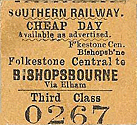 |
Despite poor relations with Sir Edward Watkin during the construction of the first section, Thomas Walker was retained as contractor for the extension, and he immediately started work on the Bourne Park estate. Sixteen elm trees having been felled, the cut-and-cover tunnel was ready for excavation. This was not the first occasion that a covered way was provided to appease a landowner, and the work is described in Matthew Bell's Chronicles of Bourne: ‘An open cutting was made as deep as the |
level of the arch springing and then a trench was dug on either side on which the walls of the tunnel were built. The arch was then turned, but with apertures left in it at regular intervals. Lastly the core of chalk left in the middle of the tunnel was removed by being hauled up in wheelbarrows on chain bridles, through the apertures, drawn by horses. The core was then deposited on the top of the tunnel until the cutting was filled to the original level.’ The bricks forming the roof of the tunnel were laid in early September 1888, and the tunnel was completed in February 1889. To finish the tunnel, chalk from the excavation was used to cover the arch, which was then topped with a thin layer of soil to restore the land to its original level. Matthew Bell, however, never came to terms with the loss of part of his elm avenue.
Only two additional intermediate stations were planned for the seven-mile section between Barham and Canterbury: South Canterbury was on the outskirts of the city, and the other served the village of Bridge, though sited some distance from it. A third station was added at Bishopsbourne at the request of Matthew Bell's eldest son. The SER agreed to this request on the condition the land was donated by the estate. Building this station brought an end to the 20-year feud between the SER and the Bourne Park Estate.
While the three stations on the southern section were largely timber-built to a traditional SER design, the three new stations were built of corrugated iron. All of the stations were provided with goods facilities, with the largest yard at Elham. There were also public sidings at Ottinge (between Lyminge and Elham) and Wingmore (between Elham and Barham).
After complaining about further slow progress, Edward Watkin imposed a deadline of July 1889 for completion of the extension. In order to avoid a financial penalty for late completion Thomas Walker employed additional men and plant in the spring of 1889, and by working round the clock the line was completed slightly ahead of schedule.
Major Hutchinson returned for his second inspection and, although there was still some work to be done, he authorised the opening of the line on the condition that the improvements were quickly completed. The extension opened a week later on 1 July 1889, with six daily trains in each direction between Shorncliffe (now Folkestone West) and Canterbury West. The same service also operated at weekends, and Sunday excursions soon proved very popular. Motive power generally came from Dover shed although there was also a shed at Canterbury West.
Construction of the Elham Valley Railway had taken almost five years, averaging little more than three miles a year, which was very slow progress compared to other lines built by Thomas Walker. Once completed, the line was 50% over budget. and had the local company not been backed financed by the SER they would clearly have gone bankrupt at an early stage. The Elham Valley Light Railway Company was officially absorbed by the SER on 25 June 1891.
Although built as a main line, the Elham Valley was in reality only an agricultural line serving no large towns and little industry other than agriculture. Test borings for coal were made in 1897, but none was found, and the only industry ever served by the line was the Elham brick company whose private siding opened in 1890. This was to be short-lived as the brickworks closed in 1905 when the clay in the adjacent pit was exhausted.
In the first few years traffic returns were encouraging, and in 1890 the service was improved with seven 'up' weekday trains and eight 'down', with the Sunday service slightly reduced to five. Most northbound services now started at Dover, with some trains running on from Canterbury to Minster, Ramsgate and Margate from where they returned to Dover via Deal. There was one daily return goods train which left Shorncliffe just after noon. This stopped at Lyminge, Elham and Barham and at the other stations by request. On its return the train also stopped at Wingmore and Ottinge if required. The principal traffic was coal, which was handled at all stations, with hops and timber at Bishopsbourne, and bricks and agricultural produce at Elham.
During 1896 the Elham Valley Railway played its part in the East Kent military manoeuvres designed to evaluate local defences, including the use of the railway for deploying big guns.
| During the early 1890s competition between the SER and the LC&DR reached ruinous proportions, with both companies offering nearly identical services to and from the same towns, which inevitably lost money for both companies. However, following the resignation of Watkin in 1894, relations between the two companies gradually improved under his successors Sir George |
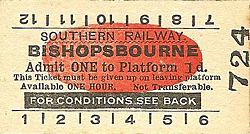 |
Russell (1895) and, most notably, under Cosmo Bonsor (1897). Bonsor managed to persuade the two boards of governors to see sense, and from 1 January 1899 the South Eastern & Chatham Railway’s Joint Management Committee was formed to oversee joint working, with Bonsor as its chairman. On 5 August 1899 the South Eastern and London, Chatham and Dover Railway Companies Act was passed, which resulted in the formation of the South Eastern and Chatham Railway. The new management had little effect on the Elham Valley line. A new halt was opened at Cheriton on 1 May 1908; although this was on the main line it was served only by Elham Valley trains. In 1904 the first steam rail-motors were introduced in Kent in an attempt to attract new traffic to failing branch lines. These consisted of a single, electrically-lit coach and locomotive coupled securely together to act as a single unit. Two of these were allocated to Dover shed and were tried on the Elham Valley line in 1911. They were used during the summer to supplement the existing service between Folkestone and Elham, with four daily services. The rail-motors struggled with the gradients up to the Etchinghill summit and in 1914, having been reduced to two a day, these services were withdrawn completely in 1916.
While initial expectations for the line were encouraging, by the turn of the century passenger returns had peaked and began to decline. With the outbreak of war in 1914 the line came under government control. There was minor disruption to services to accommodate troop trains, and the Elham Valley was considered a useful secondary or diversionary route. The line was used as such in 1915 when a landslip at Folkestone Warren closed the main line, and the Elham Valley was used as a long diversionary route between Folkestone and Dover via Minster and Canterbury.
Alterations were made to the junction at Cheriton to allow valley trains to cross to the 'down' main line. On 2 September 1915 The Royal Train used the line when King George V and Lord Kitchener alighted at Lyminge, where they mounted horses and rode to Beechborough Park to review the troops.
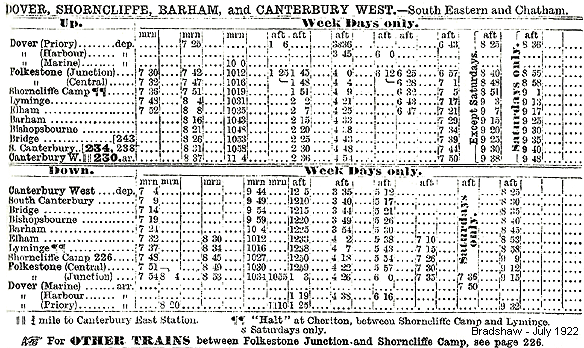 |
In 1916 the Sunday service was withdrawn, and single-line operation was introduced allowing the other line to be used for the storage of wartime supplies.
Although normal services were resumed at the end of hostilities, passenger numbers continued to decline. The East Kent Road Car Company was established in 1916, and in May 1919 the first bus service ran through the Elham Valley; this had an immediate effect on passenger receipts. In 1923 the line came under the control of the Southern Railway under the 1923 Grouping, and in 1928 the Southern acquired a 49% share in the East Kent Road Car Company; this inevitably led to a run-down in rail services.
In an attempt to save money, the Southern announced staff reductions and singling of the line. This took a number of years to implement, but in 1931 the line was singled between Harbledown Junction and Lyminge. Through the 1930s, what was one of the most scenic lines in south-east England settled down to a quiet existence, with valley residents and passengers unaware of the upheaval that was to follow at the end of the decade. By 1937 the passenger service had been reduced to five daily trains.
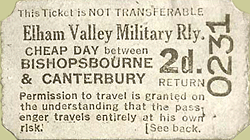 |
The outbreak of war in 1939 initially brought few changes, but by 1940 a German invasion was expected. On 25 October the passenger service between Lyminge and Canterbury was suspended, and the military authorities took control of the line for the duration of the war. Passenger trains continued to run between Lyminge and Folkestone, although Cheriton |
Halt was closed for the duration of the war. The daily goods train service continued under the control of the War Department; the WD also ran a service of recreation trains for military personnel on Wednesdays, Saturdays and Sundays. The general public were allowed to use these trains ‘at their own risk’, and special tickets were issued.
The loops at Canterbury South and Elham were re-laid, and extra sidings were provided north of Lyminge and at Bourne Park where the former 'up' line was re-laid as a loop through the tunnel. Two 12-inch railway guns were brought to the sidings at Lyminge but, following an air raid, they were moved Elham.
The German invasion of France and the Low Countries began on 10 May 1940 and a British invasion was expected to follow. German artillery units now had a commanding position along the Channel coast, which was essential if they were going to launch 'Operation Sealion', the proposed seaborne assault on south-east England. Several batteries of German guns were rail-mounted.
In the 1930s the English Channel was defended by short-range artillery left over from the First World War, which would be totally inadequate during the expected invasion. One of Winston Churchill's first tasks as Prime Minister was to search for extra fire-power, with three categories of defence required for the Straits of Dover. Firstly there were long-range guns which could bombard targets in France; secondly there was need for intermediate-range guns capable of hitting enemy shipping in the Channel; and, lastly, there was a requirement for mobile super-heavy rail-mounted guns which could be used against shipping and artillery targets and, if the need arose, be withdrawn to pound the invasion beaches.
Railway-mounted guns played an important role during WW1, and Major Montague Cleeve was the commanding officer in charge of one railway gun HMG Boche-Buster. On his return from the Far East in November 1939, Cleeve found Boche-Buster in a transport shed at Ruddington, covered in cobwebs. During 1940 the carriage was taken to the railway workshops at Darlington (near Catterick) and after being mated with the 18-inch barrel from the Royal Arsenal it became the largest of the British WWII heavies.
Boche-Buster was manned by 50 men and several specialist gunnery officers from the 2nd Regiment Royal Artillery (RA); the complete battery of 80 men was known as the 11th Super Heavy Battery.
The Elham Valley Railway was quickly made ready for the arrival of HMG Boche-Buster. Four brick magazines were built in the cutting north of Bourne Park tunnel, and steps were cut into the banks either side of the southern portal of the tunnel where the gun would be housed. The military, it could be said, owed quite a debt to the stubborn Matthew Bell and his insistence that an unnecessary tunnel should be built so as not to spoil the view from his bedroom window.
Boche-Buster arrived from Catterick on 13 February 1941, the gun was pushed out of the tunnel by a WD diesel locomotive, through Bishopsbourne station to the Kingston spur, where it was fired for the first time, sending several rounds into the English Channel.
The battery had its headquarters at Charlton Park with offices at Bishopsbourne station. Although it never fired in anger, the gun was frequently photographed in aggressive poses and was billed as a 'fearsome cross-Channel monster'; but the truth of the matter was that, being a howitzer, it had barely enough range to command the Kent coast and had no hope of putting a shell even half-way across the Channel.
At the beginning of May 1943 the Southern Railway withdrew the passenger service between Lyminge and Shorncliffe; thereafter the Military were the sole users of the entire branch. The Elham Valley Military Railway provided its own passenger trains for military personnel, but members of the public were allowed to travel on these at their own risk. Special tickets were issued, with an example shown below.
In March 1944 an inspection was made of the line by the SR shortly before it was officially de-requisitioned by the War Department. Subsequently they drew up a list of necessary repairs and compensation in order to reinstate the goods, and possibly passenger, services.
| The daily goods service was reinstated from 19 February 1945, but the Southern Railway were reluctant to restore the passenger service. However in the summer of 1946 they announced that the line would reopen to passengers, but only between Lyminge and Folkestone, with six passenger trains each way on weekdays and seven on Saturdays, but no Sunday service. The restored service began on 7 October, but was little-used as |
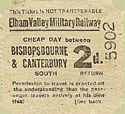 |
former passengers were now accustomed to travelling by bus and saw little reason to go back to the less convenient, and less frequent, rail service.
It was clear from this half-hearted effort to restore the service that the Southern wanted to close the line; so it came as no surprise when they announced in the following spring that the line would close from 16 June 1947 unless passenger numbers improved. With only 12 passengers a day, and very little goods traffic, it was clear that the line had no future.
There were some local protests about the impending closure but they fell on deaf ears. With no increase in passenger receipts the line closed to passenger traffic on 14 June 1947. A limited freight service continued to run on Mondays, Wednesdays and Fridays for heavy goods only. This continued for a few months while customers made alternative arrangements. The line officially closed on 1 October, and track-lifting started almost immediately. The track was severed half-a-mile south of Harbledown Junction in September 1948, and track lifting continued southwards. When the contractors reached Barham all work stopped, and it was not until the summer of 1953 that track-lifting reached Elham. Track-lifting was completed in 1955, followed by the removal of bridges over roads.
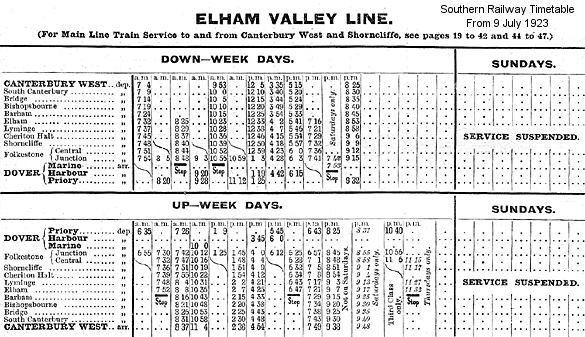 |
Today much of the route has returned to agriculture but in some places it can still be seen, although often heavily overgrown and impenetrable. The section between Peene and Cheriton Junction has been eradicated by the Channel Tunnel terminal building. There is a small railway museum at Peene adjacent to the line; this contains many artifacts of railway history and a working model railway depicting the line in SER days. From Peene the route can be traced through the Etchinghill tunnel with the 80ft-deep cutting at either end. The tunnel is dry, but the approaches are damp. To the north of the tunnel there is an impressive three-arched brick bridge that has only ever carried a bridle path. The course of the line peters out on the outskirts of Lyminge. The route can next be seen at Elham where the Elham Valley Way footpath follows it for 500yd north of the station, until it turns sharply to the east. The line can then be followed as a farm track to its junction with the Valley Road. From the road there is little to be found until Kingston where the route is once again clearly seen right through to the outskirts of Canterbury, passing through Bourne Park Tunnel and Bishopsbourne and Bridge stations. Surprisingly the route is largely intact as it runs to the south of Canterbury along the edge of the built-up area. It is lost once again at Wincheap, but then reappears curving to the north to reach the junction at Harbledown. The only part of the line that is a public right of way is the short section of the Elham Valley Way.
Click here to see a 12 minute film of HMG Boche-Buster on the Elham Valley Railway
Click here to see a short British Pathé film of HMG Boche-Buster
Route map drawn by Alan Young, Bradshaw from Chris Totty, tickets and Southern Railway timetable from Michael Stewart
Other web sites: The Elham Valley web site, The Barham web site, Railways in Kent (Ken Elks) & Elham Valley Railway Museum.
Sources:
- The Elham Valley Line 1887 - 1947 by Brian Hart - Wild Swan Publications 1984
- The Elham Valley Railway by M J Forwood - Phillimore 1975
- Along the Elham Valley by Brian Hart - Article in Railway Magazine March 1979
- Military Railways in Kent by R M Lyme - North Kent Books 1983
- British and American Artillery of World War 2 by Ian V Hogg - Greenhill Books 2002
- The Kentish Heavies by John Reed - Article in After the Battle No. 20
- Wikipedia - various pages
To see other stations on the Elham Valley Railway click on the station name: South Canterbury, Bishopsbourne,
Barham, Elham, Lyminge
& Cheriton Halt
See also Bourne Park tunnel & Etchinghill tunnel
See also HMG Boche-Buster - rail mounted gun
|

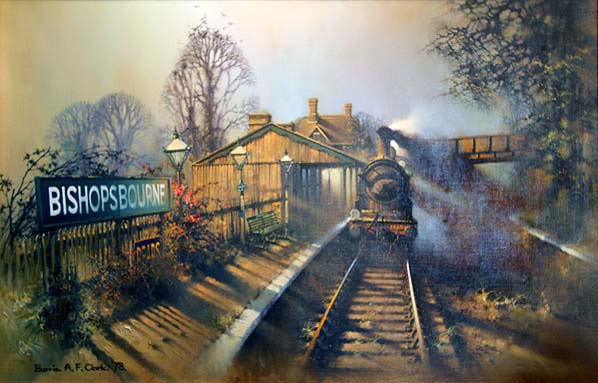

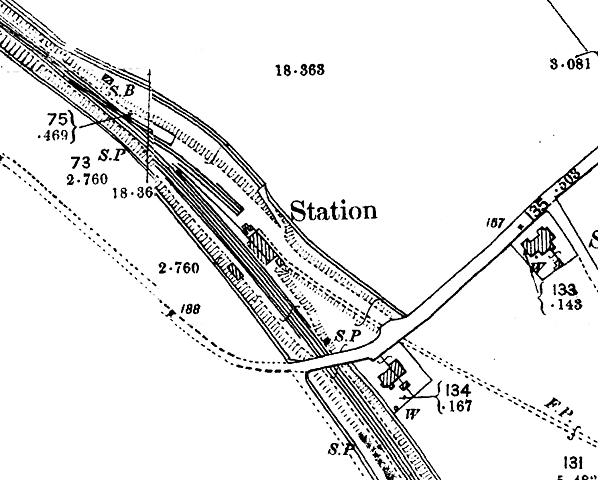
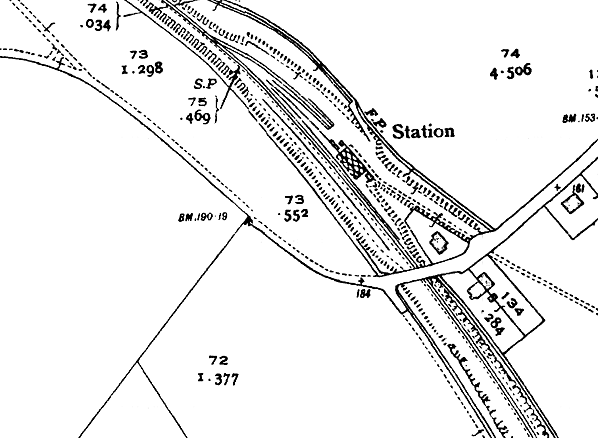
old2.jpg)
old3.jpg)
old1.jpg)
old4.jpg)
14.jpg)
14.jpg)
4.jpg)
6.jpg)
8.jpg)









12.jpg)

 Home Page
Home Page